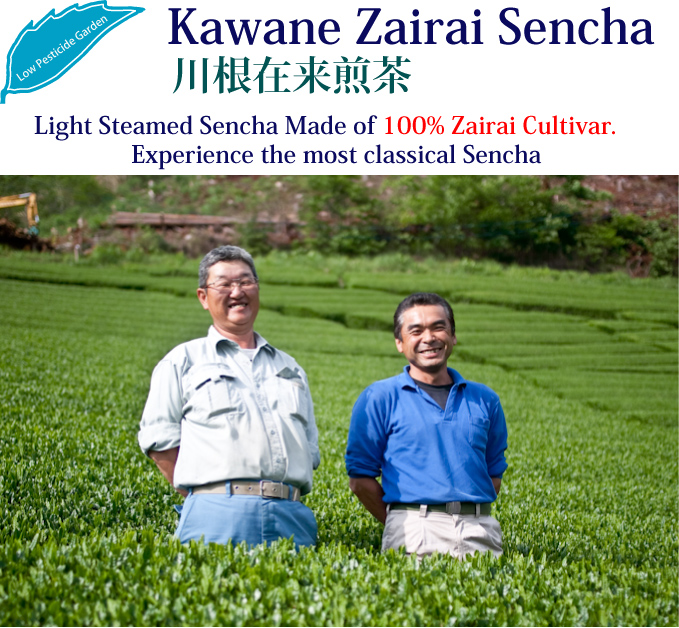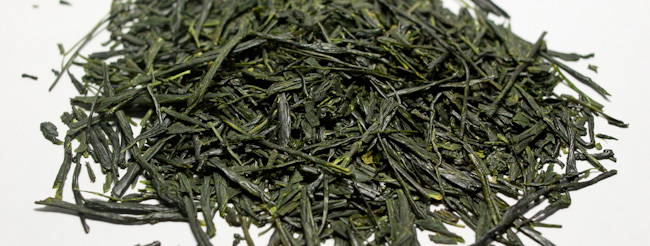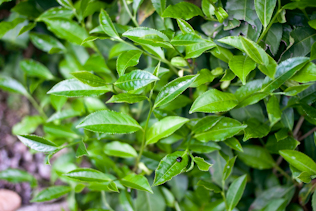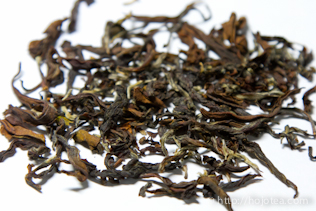
Thank you for visiting HOJO website. If you have any enquiry, please feel free to get in touch with us at
▼ Akira Hojo
▼ Hojo Newsletter
▼ HOJO FACEBOOK





HOME > Green Tea >Kawane Zairai Sencha

Japanese tea industry has long been following a set of quality criteria to evaluate and set the price of Japanese green tea in the tea market. However, sometimes these quality criteria may be biased against certain good quality tea that does not meet their criteria. Thanks to their prejudice, we can happily selects this “diamond in the rough” with a much affordable price.
Kawane Zairai Sencha is a light-steamed Sencha (Asamushi Sencha). It is produced in Kawane. Kawane is located at the upper stream of Oui River (大井川) which is also a tea production area. It is as famous as Hon Yama (本山) where is located along the Abe River (安倍川). Recently, Deep Steamed Sencha is getting very popular among tea drinkers in Japan and the number of Deep Steamed Sencha in the market is becoming overwhelmed. Nevertheless, we particularly select a light-steamed sencha as we want to introduce a Japanese tea that gives a refreshing and pure taste. The color of Zairai Sencha is as light as white wine, yet it gives depth and thickness in taste.
The biased judgment on the quality criteria of Japanese tea industry gives us an advantage in selection. We managed to pick up a good quality tea with lower price.

To be honest, the price for Japanese tea is not set in proportion to the quality of tea in general. In Japan, the quality of tea is set with very strange and biased criteria. In fact, these criteria are very far away from what actually the tea drinkers are looking for. In any case it is a customary in Japan tea industry to follow those criteria. There are 3 major factors that influence the price of tea in Japanese tea industry, as follow:
Popular cultivar such as Yabukita gets higher price compared to other minor cultivars.
In a way, any tea that goes against these 3 criteria mentioned above would be set at much lower price. In fact, criteria No.1 and No.2 have nothing to do with the quality of tea in terms of taste and flavor. Within the same production area, tea that can be harvested earlier in season comes from the tea garden located at lower altitude. For tea garden located at higher altitude, harvesting of tea leaves can only be started about half a month or one month later. Needless to say, the quality of tea produced at higher altitude is much better.
Besides, the shape of tea leaves does not affect to the taste and quality of tea too. For Japanese tea, the appearance of tea leaves is affected by the rolling process and absolutely has nothing to do with the quality of a cup of tea. Taking advantage of those prejudices in Japanese tea industry, we happily look for good quality tea at a lower cost.
Note:Thanks to the above criteria, there is always discrepancy in quality. For example, the tea produced at the garden located at very low altitude, from Yabukita cultivar and produced by a master who is good at controlling the rolling process will surely be simply very expensive. It will be sold as the most exclusive tea in Japan. However no doubt that those expensive teas give relatively flat taste and weak flavor.
For us, the definition of good quality tea is about the intensity of after taste and richness of flavor. This is a very common quality criterion in Taiwan, India and China, yet in Japan, very few people pay attention to after taste and flavor of tea. As we do not wish to follow the quality criteria of Japan, we can easily find good tea at lower cost.
The distinctive characteristic of this Sencha is that it is 100% made of Zairai cultivar. Zairai in Japanese language means "existed for a long time" or “native”. This is the exact meaning of the tea tree itself. The word “Zairai” is used not only just for tea but also for fish, fruit and many other things. "Zairai Trout" means the native trout of Japan. Tea is a sub-tropical plant and the origin of tea is from Yunnan province of China. Ecologically there has not been any native tea tree ever found in Japan. According to the history, tea was brought to Japan from China once upon a time. The name of “Zairai”, however, is a little tricky in this context. In Japan, any tea that has long existed there was called Zairai cultivar. But it seems that there are various kinds of Zairai cultivar. Technically, Zairai cultivar that exists in Kyoto and Shizuoka is of different cultivars. Even in Shizuoka prefecture, it seems there are a few different kinds of Zairai. In any case, all of them are just called Zairai.
The Kawane Zairai has reminiscent of Oolong cultivar. Its fresh tea leaf gives a flowery aroma that is similar to fragrance of orchid. When visiting tea garden right after plucking is carried out, it was like standing amidst in a flower garden.
One of the characters of Zairai cultivar is that it produces much longer root compared to conventional cultivar. Hence the longer root absorbs more minerals and tends to produce tea that gives richer taste and flavor. The richness of tea does not mean strong bitterness or astringency, but the depth of taste. In fact, it gives a very refreshing taste just like white wine and it lingers in our throat for some time.
Usually the older the tree, the better the quality of leaf it produced. This is due to the length of root and surface area. Tea tree that produces tea leaf for Kawane Zairai Sencha is at 50 years old on average. It is not considered very old. However, it is considered as the oldest Zairai in Kawane area.
Usually tea industry (not referring to the consumer market) in Shizuoka is craving for Yabukita cultivar. It means that the Yabukita cultivar will get a better price as compared to other cultivars. Zairai cultivar only remains in mountainous area and rarely found at low altitude. The quantity of Zairai tea leaf is very limited. So far, the Zairai tea was blended with Yabukita cultivar and never released to the tea market as it is. Under the circumstances, there is no chance to find Kawane Zairai tea in retail shops in Japan. We targeted a specific Zairai garden and visited on the day when they were making Zairai tea. We selected the best batch out of a few productions and managed to purchase genuine and pure Zairai tea that was not blended with any other tea. The only thing that is unfortunate for us is that we need to commit for a larger quantity in order to secure 100% Zairai.

The tea leaf on the left is Zaira Sencha, while the one on the right is sencha made of Yabukita. The Zairai leaf is darker green and shining.
The farmer who supplied Zairai tea to us is also producing Yabukita cultivar as well. The interesting point is that every year they make sure keep some quantity of pure Zairai tea for own consumption. Throughout the year, the family enjoys Zairai cultivar. No doubt that the tea farmer always knows the best which tea is delicious.
The tea garden is located at 500-600m above sea level. It is located very deep inside the mountain. At such area, they even encounter wild animals very often. As we selected Zairai tea, which tea garden is located at higher altitude and spring comes late, the cost of tea is not very high. That is how we managed to obtain quality tea at lower cost. Kawane Zairai Sencha also very rich in minerals. It is also suitable for those who need more minerals.
 |
 |
|
| The tea leaf of Zaira cultivar: Relatively small leaf and the edge is sharp |
|
In you are using tap water, it is necessary to filter the water using an activated carbon filter. If not, you wouldn’t be able to enjoy the authentic taste of tea. Chlorine is added to tap water in order to sanitize bacteria. This chlorinated water will also harm our body cells. Concerning about our health condition, it is very important to remove chlorine from drinking water. The most effective method in removing chlorine is to install an activated carbon filter. This type of filter is designed for removing organic substance. It will remove not only chlorine, but also other harmful substance such as contaminated pesticide. The activated carbon filter can be easily obtained from the common hardware shop in most countries. If activated carbon filter is not available, please place a charcoal inside the water and leave it for over night. The material composed of activated carbon filter is made of ground charcoal. The difference is that activated carbon filter contains much finer particles and hence it has extremely large surface area for a better efficiency in filtration. We do not suggest RO water (reversed osmosis water) or distilled water. This water carries no mineral, the taste and flavor of tea tends to be very unstable, unless you have very superior quality tea and tea equipment.
In the long run, you may observe a thick layer of scale accumulated inside your kettle. Our mother usually taught us to wash and remove it with citric acid. But please do not even try to remove the scale. Scale consists of minerals that exist in the water. The mineral composition is reflected from the water you used. If you remove the scale, the mineral ion balance between scale and water is destroyed. This balance is called buffer effect in science. The flavor and taste will seriously run out and you won’t be able to get previous taste and flavor for a long time. It is also important to stick to the same type of water whenever brewing tea. If source of water is changed, it carries different type of minerals. It will affect the mineral ion balance too.
Go to further information about suitable water for brewing tea >>
The quantity of tea leaf can be calculated by a formula that "Divide the Volume of Water by 5". For example: the volume of teapot = 200ml; 200ml/50 =4g. You need to measure 4g of tea leaves for 200ml of water. As opposite to the traditional brewing method, the modern style uses more volume of water. A teapot with the size about 150-220ml is just nice for one person.
Cool down the boiling water to 80 degree Celsius. Use the same temperature for a series of brewing until you feel the taste no long remains. Finally, you can use boiling water to bring out the remaining taste and flavor.
For sencha, the first brewing period is 1 minute.The second brewing must be less than a few seconds. The third brewing is the same. From the forth brewing onwards, increase to additional 10 seconds for the each subsequent brewing.
Clay teapot and Tetsubin makes the taste of Sencha even better. It is mainly because of the iron that is released from the equipment. In particular, the iron enhances the depth of after taste.
Most of Green Teas can be brewed in cold water. The higher the grade of tea, the more suitable it is with cold water brewing.
1. Measure 1 table spoons of tea leaves for 500ml of water.
2. Pour the water into a glass jar or bottle and leave it for more than 1 hour.. It is also a good idea to put the tea leaves directly into a PET bottle.
3. Gently sway the container in order to get an even concentration.
4. Usually the taste of tea gets thicker when it is brewed for more than a few hours. In this case, pour in additional water. Eventually tea can be brewed more than 1 liter per 1 table spoon of tea leaves.
1. Measure 4-6g of tea leaves for 200ml of water.
2. Pour water into a clay teapot and brew for 3 minutes.
3. For second brewing, brew for 20 seconds. Alternatively you can also switch to hot water from second brewing onwards, if you wish. If using hot water for second brewing, pour boiling water and brew for less than a few seconds. Since tea leaves are very cold and wet, the temperature drastically drops to less than 60 degree Celsius.
The benefit of cold water brewing is tea can last for a whole day and the taste is refreshing with a natural sweetness. Thanks to the cold water extraction, the level of caffeine in tea is very low. You would not suffer from sleepless nights. Even kids can enjoy this tea.
Once a bag of tea is opened, please finish it within 3 months if you wish to enjoy its freshness. From the medical point of view, it is safe to consume the tea even if it is kept for a few years. However the freshness disappears if it is kept for too long. Tea must be tightly sealed before it is kept. Tea should be kept in ambient and dry conditions such as in the living room, but it must be completely away from humidity. Tea should not be kept in the kitchen as the environment is very humid. Avoid enclosed area such as inside the cupboard or drawer as these places are damp. Also avoid opening the bag of tea in humid atmosphere. It is recommended to open the bag during a sunny day or under air-conditioned atmosphere. Once tea leaves absorb moisture, deterioration of tea will be triggered within a few days. Tea will then give an astringent taste, sometime it tastes sour. The fresh aroma also becomes weaker.
The quality of tea lasts longer if it is kept in the fridge. However we strongly recommend you not to keep tea in the fridge. When tea is withdrawn from the fridge, there is usually condensation. Once tea is exposed to moisture during condensation, the quality will deteriorate within a few days. The higher moisture content in the tea leaves will trigger oxidation and it will completely destroy the quality of tea.
Here’s one frequently asked question: what happens if bag is sealed using tape or tea is packed in zipper bag and kept inside the fridge?
For your information, these simple sealing methods are not sufficient. When the bag is withdrawn from the fridge, it is cold inside the bag and therefore causes negative pressure. Air will be drawn from outside and condensation will occur. In addition, if the bag is taken in and out from the fridge very often, this will cause heat stress to the tea leaves as temperature is increased and decreased very frequently. If tea is kept in the fridge, when it is withdrawn from the fridge, it is necessary to leave it in ambient atmosphere for more than 24 hours in order to warm up the tea leaves. Based on our experience, 12 hours is not long enough. We may think tea is warmed up, but inside the bag, the tea leaves are still cold due to insulation effect.

Please feel free to send us e-mail for enquiry at:

 |
We accept various kinds of credit card through Paypal.
Only if customer prefer other option of payment, we suggest "Bank Transfer".
Various choice of shipping method
EMS, SAL, Small Packet, Small Packet (SAL) Yamato Express and Surface
For shipping tea, we usually suggest small air parcel, the estimated shipping cost of tea in 100g (with wrapping material ) is
Small Parcel
USA JPY 600, EU JPY600 and Asia JPY470
Small Packet (SAL)
USA JPY380, EU JPY380 and Asia JPY320
The shipping fee to oversea by small air parcel happens to be even cheaper than domestic shipping fee in Japan.
For your information, some countries, EU in particular imposes custom duty. We need buyer to bare the duty. We are sorry, but we cannot change the amount on the invoice, and we do not mark any packages as gifts. We will strictly follow the custom regulation.